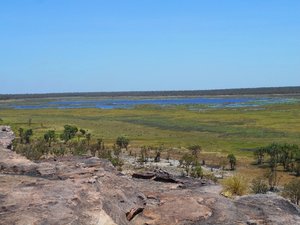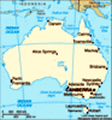Advertisement
Published: September 8th 2014

 The Spectacular View of the Wetlands from Nadab Lookout
The Spectacular View of the Wetlands from Nadab Lookout
This is just part of the habitats we could see from up here.We set of towards Ubirr, 40 km from Jabiru, another rock art site rated by most as even better than Nourlangie. We should have gone a bit earlier as the day was getting hot already by the time we arrived. We went into the Border Store to see if they had a map or guide sheet but they didn’t. It’s right on the border of Arnhemland, which is an area that requires special permits to enter and is the only shop beyond Jabiru. They had nothing we needed, though, so we headed for the Rock Art.
It was about 11 am by the time we got to the Ubirr walking track so we made sure we had hats, sunscreen, mozzie repellent and plenty of water. The walk itself was quite easy with just a few spots to climb over rocks to get a closer look at the art works. The first gallery had some quite old paintings but they were very faded and hard to see but just around the corner it started to get better.
There was a large stick figure of Mabuyu, one of the ancestors, carrying a dilly bag over his shoulder,

 Pandanas Seed Pod
Pandanas Seed Pod
This bright pod is actually just part of the main pod - a cluster that grows at the tops of the Pandanas tree.a throwing stick and spear in one hand and a goose-wing fan in the other. The story is that a group of people stole the contents of his dilly bag, all his food. Later, after following them until they took shelter in cave, he rolled a rock in front and sealed them all in. This story is told to remind people not to steal. The goose-wing fan and spear place this painting in the Freshwater Period and so less than 2,000 years old.
Another gallery had a few crosshatching paintings mostly of animals like a long-necked turtle and some fish.
The Main Gallery was the best of all. It was in a shelter under a very large rock overhang with deep shade and a lovely strong breeze blowing through it. That was a relief as we were starting to get hot. Most of the paintings were of food items showing what was available in the area or a catch that the painter had been especially proud of. We saw Barramundi, Salmon Catfish, Saratoga and Mullet (which you can tell by the broken neck and flipped back head on the painting – this fish keeps flopping around

 Mabuyu Catching His Meal.
Mabuyu Catching His Meal.
A group of people stole the fish that Mabuyu had caught, according to the local clan story. He was so angry he waited for nightfall then sealed them into the rock cave they had been sleeping in. This is meant as a lesson in the evils of stealing, especially food.when out of water and can end up jumping back into the water so they snap its neck immediately and show that in the picture). They also paint Long-necked Turtles, Wallabies, and occasionally a Goanna.
The other type of pictures are hand prints and a few of the stick-like Mimi figures (1
st spirit ancestors from the Dreamtime that paint themselves) but these were over-painted and you could only just make out some of the features.
Most interesting were the two Boss Man figures. These come from about 300 years ago and are Contact pictures relating to white man’s first interactions with the Aboriginals. They were the Dutch merchant ships which came to the Top End to trade and later to hunt water buffalo (no-one has explained who introduced the buffalo if it was that far back!). The Boss Man would be supervising the trade or hunt and is depicted with both hands in his pockets, boots on his feet and a pipe hanging out of his mouth. We found one very small white figure and then spent about 10 minutes trying to find the 2
nd one, which we thought was black but turned out to be

 A Long- Necked Turtle
A Long- Necked Turtle
These were a favourite with the locals, especially the sweet yellow fat deposits shown in this decorative X ray painting.done in yellow ochre and quite high up between a large detailed turtle and a colourful fish. Not prominent at all – which says a lot about how important they thought the contact was, I think.
After the Main Gallery, the path headed further up the escarpment to the Nadab Lookout at the top. When I say path, I mean a few coloured orange arrows stuck onto rocks on the ground pointed to the way to go across and up the rocks. They had placed a few extra rocks in strategic places to act as stepping stones when the hop to the next level was too big, but mostly you just picked your way around and found the best route for yourself. I went slowly and was very glad of my stick acting as a third leg but managed OK. It was well worth the effort, too. The view was spectacular and showed a wide range of habitats, from wide open flood plains with water pockets and lovely lush green grass; to rocky escarpments, like the one we were on, with their interesting shapes; to Monsoon Forest, little pockets of forest that hide within the escarpments and

 Part of the Main Gallery at Ubirr
Part of the Main Gallery at Ubirr
This was just part of a very decorated shelter. The artwork, mostly fish and water foods, has been added to many times with many paintings on top of older ones. They believe the gods can still see them. No-one is allowed to touch the work of someone else as it was a message to the gods for that especial time. To repair another person's art is extremely disrespectful. If you look carefully you can see the white Boss man figure. , with his big boots, just above the large kangaroo, and to the right of the left=hand fish. are full of bird-life; to the edges of Arnhem Land. It was amazing.
Barry went up one more level, right to the top and had an even better 360
o view but it was rather more difficult climbing so I opted to enjoy the scenery at the lower level. I found a spot in the shade of one of the huge boulders looking over a small forest pocket. I could hear birds but the only ones I saw were a pair of Black Red-tailed Cockatoos that flew into a tree nearby, but hidden in the leaves, and my little friend the Rainbow Bee-eater that was continually flitting in and out catching dragonflies and then bashing them on the branch before eating them. I also saw a cute tiny jumping spider exactly the same colour as the sandstone he was sitting on. If he hadn’t moved I wouldn’t have seen him.
When Barry finally came back down and we’d both drunk more water, we set off back down the escarpment towards the car park, with a light detour to see one more gallery. This one had the health warning that we’d heard about during the slide show

 A Mullet with its Neck Broken
A Mullet with its Neck Broken
Mullet are always shown this way as they flop about when beached until they manage to fall back into the water so the local people. the other night, a red stick figure with swollen glands all over his body. It was a warning about the “Sickness Country”, areas with uranium that the locals had learned to avoid. I did wonder how a picture like that could help others know where to avoid, as there was nothing else with it. Maybe it goes with an oral story and is just a reminder to warn people.
We walked the last few hundred metres through the bush, getting hotter by the minute in the 35
o C heat and no breeze down there. I was glad to get back to the air-conditioning in the ute, where we had some bananas and drank a litre of ginger cordial between us.
We left Ubirr and went to Bowali Cultural Centre, where there is a café (which was unusually closed for the day, unfortunately) and a very interesting display showing the development of the land from 20,000 years ago and how the Aboriginals adapted their practices to fit in with them. One big change was from using boomerangs to hunt large macropods in open plains to using spears launched from throwing sticks at smaller game once the forests

 Watch Out - Croc Overhead!!!
Watch Out - Croc Overhead!!!
Not where you'd expect to find a crocodile! This display was showing what it was like underwater in the river. appeared. There was also lots of information on the plants and animals they eat and use still, with life-sized models or colourful pictures set in small habitats. One display looked as if you were in a river with images of fish all around you, some duck feet hanging down and, above your head, a HUGE crocodile swimming amongst Lotus Lillies (well hanging there actually). Glad he wasn’t alive!
Outside, there was a bark canoe (full of holes so it wasn’t going anywhere) sitting in a fake creek of running water with some small fish swimming around, all under the buildings eaves. From there we went back to the ute and to Jabiru.
We were both exhausted so after having a quick reheated meal and lots more to drink, we had an early night.
Advertisement
Tot: 0.127s; Tpl: 0.015s; cc: 9; qc: 53; dbt: 0.0732s; 1; m:domysql w:travelblog (10.17.0.13); sld: 1;
; mem: 1.1mb









